Hyaline Cartilage
Hyaline cartilage is the vital substance lining the bones in your joints.
Connective tissue is subject to serious degenerative changes because it has no blood supply. It is the very hard substance that lines the bones in a joint; the material that takes the strain in the working parts.
This is what a normal hip looks like. See how super smooth the cartilage is?
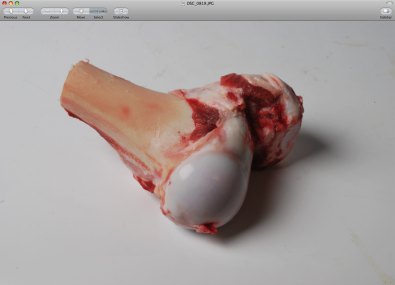
Cartilage is what we call a connective tissue. It can be very flexible and soft as in the ear lobe, or flexible and tough as in a ligament or tendon.
But what really interests us today, is the hyaline cartilage that lines the bones in our joints; stresses applied to them, particularly those that are weight-bearing, play an important role in the development of degenerative change. Knees, hips and ankles are particularly at risk.
I had a photograph here of the ball from the hip of a pig, brought courtesy of a butcher patient.
Hyaline cartilage is vulnerable because it has no blood supply; it is utterly dependent on the continuous supply of fresh synovial fluid to provide nutrients and oxygen, and remove waste products.
Hyaline Cartilage
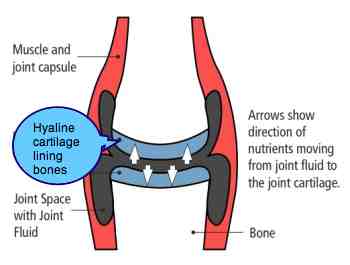
It is very hard and slippery, enabling us to bend our knees, take a great deal of weight in the hip, and twist our spines, all with minimal friction between the opposing joint faces.
That would include our fingers and virtually all our joints with a few exceptions.
Take particular note of the little white arrows. They show the movement of nutrients from the synovial fluid as it sloshes about in the joint, not literally, to the hyaline cartilage on the ends of bones.
Without that flow of fluid, carrying nutrients and oxygen to the living hyaline cartilage, it would soon lose the ability to heal itself and begin to degenerate.
What is critical about cartilage is that, unlike other connective tissues such as bone, it has no blood supply. It is utterly dependent on the synovial fluid within the joint for its nutrition.
No rich sloshing fluid bathing the hyaline cartilage, and it will degenerate and die; and hurt. There will be lots of pain.
Put simply, damaged cartilage has far more limited ability to regenerate. Bone is flooded with blood and heals quickly; that tissue lining the joints is not.
Chondroitin sulphate you will see regularly in shops. Does that say anything to you? Have you seen it on the label of bottles in your health food store?
The gelatinous ground substance of cartilage is make up largely of chondroitin sulphate, into which is embedded collagen and elastic fibres made of protein; hence you will see that it often comes with glucosamine, the precursor of proteoglycans, substances found in that tissue lining the joints.
Those fibres make cartilage flexible and very resistant to compression; it is that property that interests us with the tissue on the ends of bones.
As articular cartilage, hyaline is found covering the surfaces of bones in all synovial joints. It reduces friction, is literally more slippery than ice, and acts as a shock-absorbing tissue.
As the cartilage in your knee degenerates it causes discomfort and ultimately severe pain as a hole wears right through the cartilage to the underlying bone. Bits break off forming joint mice that get stuck in the joint causing severe pain on straightening the leg.
- Read more about symptoms of arthritis in the knee.
Cartilage is produced by cells called chondroblasts which are found along the vulnerable edge of the cartilage end plate. This is the place where new cartilage growth occurs.
In HC the protein collagen fibers that are embedded in the chondroitin matrix are very uniform giving cartilage its hard, uniform and slippery-white appearance. Typically, perichondrium is found around hyaline cartilage.
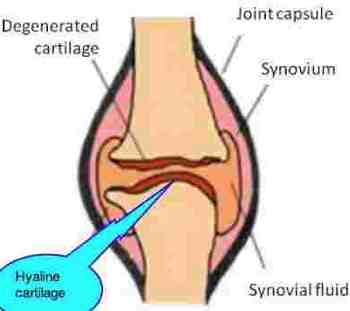
Fibrocartilage
The discs in our spines are made from fibrocartilage.
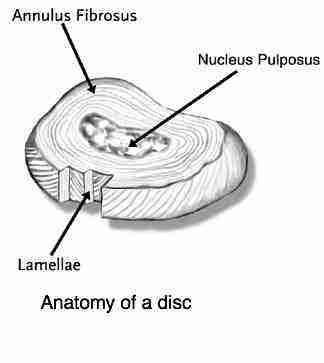
On the other hand the disc between vertebrae in your back is made up of two parts.
- The so-called "nucleus pulposis", a bubble of gelatine made up of substances called "glycosaminoglycans", made from the substrate glucosamine sulphate. Healthy glucosaminoglycans are able to bind water, and water is incompressible. This gives the disc its shock-absorbing properties.
- The outer ring of the disc is called the "annulus fibrosus". It is made from fibrocartilage, powerful collagen fibres arranged in a criss-cross ring, and attached deep into the endplate of the bone by very strong roots called Sharpey's fibres. Healthy cartilage is able to stretch outwards.
When you lift something heavy, the nucleus bulges into the annulus and, being a liquid and thus incompressible, it also presses back against the vertebrae, pushing them apart. Healthy annular cartilage contains this bubble of water-rich, gelatinous gel (it looks a bit like egg-white) as it bulges.
But diseased cartilage, particularly if you twist at the same time as bending and lifting, may rip allowing the gel to leak out. That is what chiropractic is all about; getting that fluid back where it belongs, without the use of drugs and surgery.
The degenerative features of osteoarthritis begin in the articular hyaline cartilage either as a result of:
- Excessive loading on a healthy joint, or
- Normal loading of a previously injured joint.
In a normal knee, for example, there is a space between the two hyaline cartilage plates; one femur and one tibia. In obesity, these bones are forced against each other and, because the growing part of the cartilage is at the surface, the pressure damages the growing chondrocytes. Large woman are particularly vulnerable, but men are certainly not exempt. Pain and disability are the cardinal features.
Dr Daniel Levitin, an eminent neuroscientist says that British women can expect to spend a quarter of their lives with a disability, and a fifth for men; the hyaline cartilage in the knee is a common offender.
Before subjecting your grinding, painful knee to arthroscopy surgery consider a consultation with your local Chiropractor. Mind-blowing medical research indicates that a sham treatment, or placebo, was more effective than the real deal.
The cartilage under the kneecap is particularly responsive to gentle chiropractic mobilisation of the patella.
The condition is known as patello femoral pain syndrome.
Cartilage enemies
It is as well to acknowledge cartilage enemies; they will cause us a lot of pain and, worse, disability. You don't mess with hyaline cartilage; it bites back.
1. OBESITY
Obesity is the number one enemy of hyaline cartilage; increased pressure, in the knees for example, makes us lose our independence; pain is an aside, in my experience, in comparison with disability.
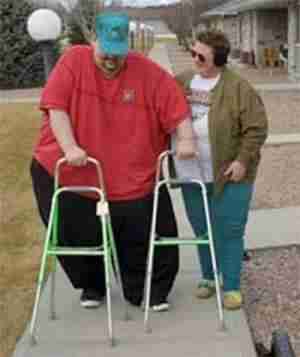
Arthritis pain in knee
Orthopaedic researchers in the Netherlands have designed a nifty device which draws the bones of the knee apart, whilst allowing them to keep moving. Preliminary results are very encouraging for those suffering from arthritis pain in knee.
Dr Lafeber's rationale for his Knee Joint Distraction technique for advanced osteoarthritis in the younger patient is that osteoarthritic cartilage is capable of self-repair if the weight is taken off.
2. SMOKING
All living tissue needs oxygen. Nerve tissue, denied oxygen, dies within minutes. Cartilage takes a little long, but the process is essentially the same: starved of oxygen, cartilage ages much faster, and the chances of restoration are much less; smoking is public enemy number one.
In back surgery it is well recognised that smoking is the biggest risk factor. Put differently, it is the greatest single factor likely to put the patient into what is known as FBS; failed back surgery. The healing tissues simply do not get enough oxygen.
Ask any Chiropractor, and s/he will confirm that in the treatment of acute low back pain with Chiropractic adjustments, that smoking with us too makes recovery more difficult. It takes longer, and the chances that you won't respond as well to chiropractic are much greater.
Low Back Pain research indicates there is a close association between vascular disease and Lumbar Disc Degeneration.
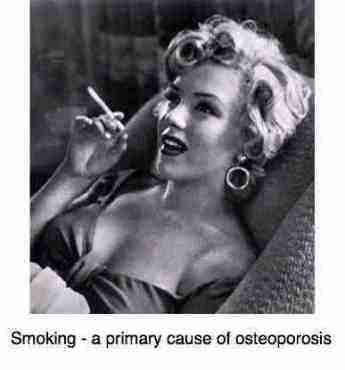
Glamorous - and DEADLY.
Knee arthritis
Arthritis pain in knee is a complex condition of degeneration of the hyaline cartilage lining the ends of the femur and tibia - major weight bearing bones. It usually comes after injury to the knee (such as torn ligaments), excessive weight and poor diet.
There is no magic formula and no treatment works really well. Chiropractic Help certainly has a contribution to make, confirmed by the number of patients we treat with knee arthritis.
Research shows the most effective treatment is also the most difficult; weight loss.
These free weight loss programs
have much to offer; cutting out all the refined carbohydrate with a
moderate increase in the healthy fats like olive oil and avocados is the
way to control the dreaded feeling of being constantly famished.
3. Poor diet
As in all disease, lack of the proper nutrients and vitamins, food rich in glucosamine and chondroitin and gelatine, the chances of the cartilage in your neck or back, knee or ankle, healing are much lower. There is now quite strong research from Harvard Medical School confirming that a rich bouillon made from bones does indeed help restore cartilage.
- CHICKEN BONES for aging cartilage ...
- FISH OIL HEALTH BENEFITS for aging and damaged cartilage.
For strong healthy bones, the body needs adequate amounts of a group of fatty acids called omega-3. They are found mainly in fatty fish, nuts such as walnuts and pecans and freshly ground flaxseed. The big plus is that omega-3 simultaneously has powerful anti inflammatory properties, as well as benefits for the heart and mind.
So too the B vitamins are essential for healthy bones and nerves, keeping the levels of a toxic substance called homocysteine down.
All in all, if you are suffering from degenerative arthritis take a good long look at your diet. Healthy Living Tips ...
4. Immobilisation
There is now oddles of research confirming that joints that aren't moving normally become arthritic. Or, to put it differently, cartilage starved of fresh synovial fluid sloshing about the joint, layering the cartilage with a substance called Hyaluronic acid, rapidly loses it glistening white slippery properties. It's called Immobilisation Arthritis. The cartilage starts to die; degeneration, stiffness and pain.
Add to this the waste products of cartilage metabolism that are not quickly removed; that is why Chiropractic subluxations are a disaster waiting to happen.
- CHIROPRACTIC SUBLUXATION ...
- Vitamin D is vital in the care of hip pain because of its affect on hyaline cartilage growth.
Summary
Cartilage lacks a blood supply and is restored far more slowly than other living tissues. But, given the right environment, your aging hyaline cartilage, and other types of cartilages as in the intervertebral disc, can heal, BUT it requires a diet rich in the necessary ingredients, plenty of oxygen, and plenty of movement.
- Take the pressure off
- Adequate nutrition
- Oxygen
- Movement, both at macro level (the whole body), and the microlevel - at the level of individual joints.
- Removal of waste products of hyaline cartilage metabolism, otherwise they start to irritate the nerve in the foramen which is located right between the joints in the spine.
And that is exactly what Chiropractic is all about!
Orange juice facts
Because bioflavonoids increase tissue permeability and collagen synthesis, something as simple as drinking a glass of freshly squeezed orange juice will contribute to the healing of hyaline cartilage.
FOOT AND ANKLE PAIN
It hardly seems possible, but almost as many patients at the Chiropractic Coalface are complaining of foot and ankle pain as low back pain. In fact, truth be told, a painful foot that makes you limp is probably the underlying cause of your lower back pain.
Take this letter received this morning from a reader, for example. Do you think she might soon be suffering from low back pain?
I sprained my ankle nearly twelve months ago, and it is still swollen and my lower leg is burning and tingling.
I had a scan four months ago. No broken bones were found.
The bridge of my foot is very painful whilst walking, and really it's not improving.
Orthotics have not helped in the slightest.
Do you have any advice for me?
Fixated joints in the foot and ankle lead unerringly to immobilisation arthritis and chronic foot pain.
Ankle joint pain and the hyaline cartilage are intimately linked.
Recommendations of the arthritis foundation
- Exercise
- Weight loss if obese
- Self management programs
- Tai chi
- Cane use
- Topical NSAIDs for knee arthritis
- Oral NSAIDs.
They strongly recommend NOT using TENS or hydroxychloroquine.
IMPORTANT CONSIDERATIONS
- HEALTHY LIVING TIPS
- Gelatine Powder for arthritis
- GLUCOSAMINE CHONDROITIN - unfortunately the research doesn't bear up the claims.
- Definition veganism
Did you find this page useful? Then perhaps forward it to a suffering friend. Better still, Tweet or Face Book it.
